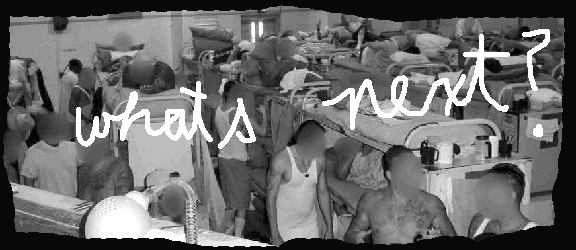
On Tuesday, the governor and the California Department of Corrections announced their collective plan to reduce the state’s prison population— and it comes down to one single word: REALIGNMENT.
The plan was, as most of you know, put forth in answer to last month’s Supreme Court ruling mandating that California lower its inmate numbers by 33,000.
Corrections Secretary Matthew Cate Matt Cate called realignment the “cornerstone” of the state’s proposed methods to solve a chronic and severe overcrowding problem that, according to the Supremes, produced “serious constitutional violations” and endangered both inmates and guards.
Realignment is just that—a realigning of which prisoners go to state prison, and which instead remain with the various counties.
Here’s how the CDCR explains it:
Under Realignment, the state will continue to incarcerate offenders who commit serious, violent, or sexual crimes and counties will supervise, rehabilitate and manage low-level offenders using a variety of tools. It is anticipated that realignment will reduce the prison population by tens of thousands of low-level offenders over the next three years.
A bill to authorize realignment was passed in Aprilbut has languished since then for lack of funding.
The shift cannot take effect unless local governments get the money to provide jail cells and rehabilitation services, and funding for that remains stalled in the Legislature. Republican lawmakers have blocked Brown’s proposal for an extension of temporary tax increases that are set to expire by the end of this month.
Renewing the recent increases in the vehicle, sales and personal income taxes is essential to funding Brown’s plan to shift low-level offenders to county jurisdiction.
Whether realignment gets funded or not, one thing that Cate made extremely clear was that, whatever California’s response to the ruling, it “does not include the early release of inmates.”
OPERATION “BRIGHT LIGHTS, BIG CITY’ GANG CRACK DOWN
On Tuesday morning, a large federal law enforcement action targeted the Varrio Azusa 13 street gang. The action— literarily titled “Operation Bright Lights Big City”—marks “only the second time in history that federal civil rights laws have been used against members of a criminal street gang, ” said a statement from the U.S. Attorney’s office.
LA Weekly’s Dennis Romero has more:
The indictment alleges the gang was run on the principle that members “will harass and use violence to drive African-Americans out of the City of Azusa and .. use violence in order to prevent African-Americans from moving into the city.”
How did they allegedly try to make their brown gang Utopia a reality? Graffiti, beatings, and robberies, prosecutors say. A black high school student was even beaten on his way home from school in last spring — just because he’s African American.
The U.S. Attorney in L.A., Andre Birotte Jr:
The Azusa 13 gang waged a campaign of hate during a two-decade crime spree in which African-Americans were harassed and attacked. We hope that this federal case will signal the end of this racist behavior and will help vindicate all of the victims who have suffered over the years.
NOTE: LIGHT BLOGGING TODAY.

Good lord – the country is obsessed with Anthony Weiner’s publicizing his privates and this blog has done nothing but stick to substantive issues. What kind of journalist are you?
(Kudos)
Ha! That really made me laugh, Bruce.
BTW, I loved Jon Stewart’s “press conference” last night, including his handling of the (real) hand laceration.
My favorite line, when Oliver said something to the effect that he was acting “Jewish” complaining about the blood, was “What am I supposed to do? Make a drink out of it like the Catholics?”
That was brilliant. He’s so fast. And the line went by like lightning. One could easily have missed it.
My position is that I want everyone who has put up pictures related to Anthony Wiener’s crotch online or on my TeeVee to resign. Along with David Vitter.
That’s about all that would satisfy my desire to…yes…make a popular drink out of somebody’s blood in this context.
I hear ya Bruce.
Between Arnold, Edwards and Weiner the news is covered with these sex scandals. Who really cares?
Based on comment #5 it appears you do.
Running a scorecard?
LAPD blew it again. Bring back the consent decree!
http://lat.ms/mfmJQm
Celeste, I thought of your blog when I read this a few moments ago:
http://www.theonion.com/articles/california-to-release-all-prisoners-who-seem-nice,20706/
Topical and all…
Kyle, the Onion story is hilarious. (And a policy I can get behind, of course. )
Just looked at that video Francis. Not pretty.
“Running a scorecard?”
I’m sure you already have the answers to all of the important questions.